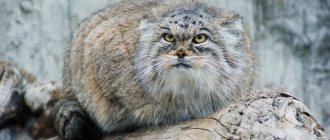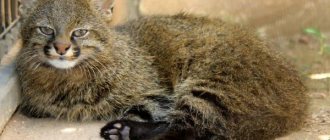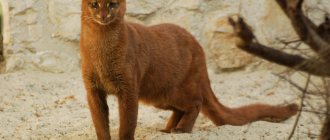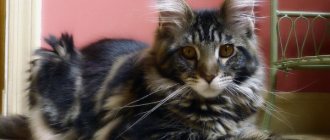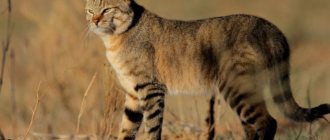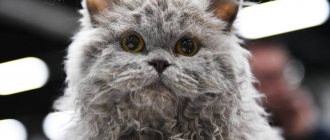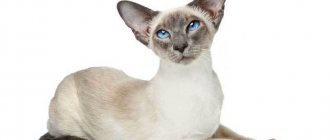Manul is a representative of the wild cat world, which, according to global network ratings, is one of the most popular exotic animals. Unusual long hair, small ears pressed to the head, and the intelligent look of amazing eyes made this cat a real Internet star.
Do not forget that this is not a breed of cute pet, it is a wild predator that is unlikely to ever be able to get along with a person.
Kinds
The Pallas' cat species includes three subspecies. They have an almost identical appearance and differ from each other only in coat color.
| Subspecies name | Peculiarities | Spreading |
| Regular (Siberian) | The color is dominated by gray and pale yellow shades | Mongolian steppes, Transbaikalia, northern China |
| Central Asian | The coat has a buffy-red hue, the longitudinal stripes in the back of the body are reddish-brown | Iran, Afghanistan, some Central Asian countries |
| Tibetan | The color is darker with a predominance of gray shades; in winter the fur becomes lighter | South Asia, Tibetan Plateau |
Appearance and body structure features
Photo: Wild cat Pallas
The small manul cat (Felis manul) has a squat body with thick, soft fur. The coat color varies from light gray to yellowish brown. The white tips of its fur give the Pallas's cat a "snowy appearance". Subtle stripes are visible on the sides of the body; the head of the Pallas's cat is round with black spots on the forehead.
The large eyes are greenish-yellow in color and the pupils constrict into a round shape, unlike most small cats whose pupils constrict into a vertical line when exposed to light. The mammal's ears are short, rounded, and located quite low on the sides of the head. Pallas's legs are short and strong, the tail is thick and drooping. It is colored with five or six thin rings and has a black tip.
Pallas' cats look fatter than they actually are due to their dense fur. They are well adapted to their Central Asian habitat, which is dominated by steppes, cold deserts and rocky terrain. Pallas' cat specimens have been found at altitudes ranging from 4,000 to 4,800 meters.
Thick fur protects the body from the cold, and the bushy tail is often used for warmth. The unique shape of the eyes and the position of the eyelid protect well from cold winds and dust. The Pallas' cat is a good climber who easily climbs rocks and jumps over crevices. The flat head and low-set ears are an evolutionary adaptation for pursuing prey in open areas with little vegetation.
Where does it live?
The habitat of the Pallas's cat consists of several zones isolated from each other. This feature of the distribution of the wild cat is associated with the animal’s attachment to certain landscapes and the almost complete extermination of the species in steppe regions with vast open spaces.
Currently, isolated areas inhabited by the Pallas's cat are located in the countries of Central and South Asia: Kazakhstan, Kyrgyzstan, Tajikistan, Nepal, Pakistan.
On the territory of our country, three zones of distribution of the species have been identified. They are located in the eastern part of the Transbaikal Territory, the Republic of Buryatia and the southeast of the Republic of Tyva.
Where does he live?
The natural habitat of the Pallas's cat extends to areas with a harsh continental climate and low humidity levels. The wild cat tolerates the continental climate well with sudden temperature changes and cold temperatures down to -40 degrees, but at the same time avoids areas where the snow cover exceeds 10 cm in the winter months.
Animals prefer landscapes dominated by treeless hills, hills, rocky steppes, low cliffs and foothills covered with grass and shrubs. Pallas' cat habitats have been recorded at altitudes of up to 4800 m above sea level.
In lowlands and forests with dense vegetation, wild cats are practically not found.
Varieties of Pallas's cat
Pallas's cat has three subtypes:
- Otocolobus manul manul or Siberian Pallas's cat is found throughout most of its natural range, but is most typical for Mongolia, China, and Russian Siberia. The animal has a grayish, rather light color.
- Otocolobus manul ferruginea is known as the Central Asian Pallas's cat. This animal has a darker brownish-red color with brown stripe markings on the body, tail and face. It lives mainly in the foothill and steppe zones of Iraq, Kazakhstan, Kyrgyzstan, Turkmenistan, Uzbekistan, Tajikistan, Afghanistan, and Pakistan.
- Otocolobus manul nigripecta or Tibetan Pallas's cat is characterized by the darkest color, in which ocher and grayish tones predominate. In winter, the fur develops a silvery sheen. The main natural habitats are Kashmir, Nepal and Tibet.
In our country, the distribution area of Pallas's cat is limited to three zones - eastern, Transbaikal and Tuva-Altai.
In the east, Manul lives in the steppes of the Chita region, in the Trans-Baikal Territory, and is found in the Buryat forest-steppe and steppe regions. In Altai and the Tuva Republic, the animal has been practically exterminated; small populations are observed only in the southeastern regions.
Now Manul is also artificially bred in Azerbaijan in the Zangezur National Park.
Reproduction
Sexual maturity in males and females occurs at the age of 10-11 months. The rutting period usually occurs at the end of February and beginning of March. Clashes may arise between males for the right to cover the female. After the mating season is over, the animals return to their territories. Feeding and raising the cubs is carried out exclusively by the female.
During pregnancy, which lasts 7-8 weeks, the cat prepares a place for future offspring. She brings from 2 to 6 kittens at a time. Until 10-12 days, babies remain blind and are completely dependent on their mother. The female feeds the cubs with milk for 3 months. Then the older kittens try to hunt on their own, remaining with their mother for several more months. Before the onset of puberty, young animals leave the female and look for a free area for hunting.
OCELOT
Features of the wild cat Pallas
According to scientists, in nature the average lifespan of a wild cat does not exceed eleven years. In the nourishing and problem-free conditions of the zoo, animals can live one and a half times longer.
External data
The official Latin name of the Pallas's cat is Otocolobus manul, and it is translated rather strangely - “ugly-eared Pallas's cat.” This cat has very cute ears - compact and sensitive. The nose is also small and in general the “face” is quite flat, which allows the cat to significantly increase the field of view. But the eyes are simply wonderful: huge, expressive, piercing yellow; It’s impossible to forget such a look.
These eyes and teeth are impossible to forget
It is interesting that even the pupils of this unique animal are arranged in a special way. In bright light, they do not narrow to narrow vertical slits, like in all normal cats, but turn into small but round dots - like in humans.
Despite its impressive appearance, the Pallas' cat is quite small in size, its body no longer than 65 centimeters. Plus, of course, 25–30 centimeters for a gorgeous tail - long, thick, rounded at the tip. An adult weighs from two to five kilograms and does not exceed the dimensions of a medium-sized domestic cat - and if it seems larger, it is only due to its luxurious fur coat.
And the fur coat is truly amazingly good! Pallas's fur is unique in its thickness and fluffiness - up to ten thousand long hairs grow on one square centimeter of the animal's skin!
A warm fur coat helps the cat's cat survive severe frosts
The body of the Pallas cat is strong and strong, its short legs are armed with powerful claws. The sharp fangs are three times longer than those of a domestic cat, and the jaws are much wider and stronger. All this forms an impressive image of an ideal hunter, which the Pallas' cat actually is.
Character
And yet, hand on heart, one cannot call him an aggressor. Pallas's cat is a predator not so much by the call of the soul, but by necessity: he wants to eat... He is actually a philosopher in life - a phlegmatic person, at best a sanguine person, but certainly not a choleric person.
A stormy temperament develops in Pallas cats only during the mating period. What can you do: even philosophers are subject to love, and to find a girlfriend, you have to fuss and even fight - a rare species, moreover, endangered.
Manul - a small but brave philosopher cat
Usually calm and balanced, the Pallas' cat shows his courageous and fearless disposition to the maximum at critical moments. The Pallas's cat needs courage not only for hunting, but also for protection from enemies. And a wild cat has many enemies in nature - these are larger canine predators, mainly wolves and feral dogs, as well as large birds of prey, from whose attacks manula kittens especially suffer.
And they say that the Pallas' cat is phlegmatic - video
Lifestyle
A hermit cat, a solitary cat, the Pallas cat prefers his own company to any other, and leads a secretive and solitary lifestyle. He is more active in the dark, but he can also hunt during the day. The main thing for Pallas cats is to get plenty of sleep. But this is not because they are lazy; the Pallas's cat has a relatively small heart, and after any stress it must be given the opportunity to have a good rest.
Manul is a big sleeper
If there are no urgent matters, a wild cat can sleep up to two-thirds of the day - until it gets hungry.
Like many cats, the Pallas's cat is not a stayer, but a typical sprinter; its short, strong legs are not able to develop, much less maintain, high speed for a long time. A quick dash is only enough for a hundred meters - but this is quite enough for a victorious attack.
Pallas's cat does not catch up with his prey - he patiently tracks it and, using camouflage coloring, tries to get as close as possible. Well, and then everything happens at lightning speed: an accurate, aimed throw - and the game is caught! Clawed paws and sharp fangs will complete the job in seconds - turning the hunt into a meal.
Camouflage is good for both hunting and protection
Since the Pallas cat cannot rely on fast paws, in moments of danger he tries to hide and mimic the surrounding landscape. And if he is discovered, he fiercely defends himself to the last, and it is precisely with his unbridled courage that he often puts a stronger enemy to flight.
Growls, hisses, but does not meow - video
Nutrition
The diet of Pallas's cat in nature consists mainly of small rodents: mice, gophers, pikas, etc.; This gourmet will not refuse to feast on some insects. Despite its apparent clumsiness, the Pallas cat is also excellent at catching birds, but this still happens less often. Sometimes, if you're lucky, the cat can even get a hare for his table, which weighs almost as much as the hunter himself, and certainly runs much faster.
Today there will be a bird for lunch
Some difficulty in keeping Pallas's cats in captivity is created precisely by the animals' need for “freshly caught” meat, which cannot be replaced with broilers from the refrigerator. Pallas's cat is accustomed to eating live food, and feathers and wool are necessary for normal digestion.
Protein forms the basis of the diet of this small predator, and the small percentage of carbohydrates it needs is replenished by eating semi-digested grains and grass - the contents of the stomachs of caught game.
Broiler in captivity will not replace freshly caught game
Reproduction
The legends that the Pallas cat is listed as the ancestor of such popular furry breeds as Siberian, Persian and Angora cats have no basis in reality. Pallas's cat is far from domestic cats in origin - these species belong to different genera and science knows nothing about hybrids between them.
The Pallas's cat walks and reproduces on its own. Females and males find each other only during the rutting period, and the rest of the time each of them strictly observes the boundaries of their own territory. The peak of love games, as with domestic cats, occurs in February-March. Then the parents separate - the cat continues to walk on its own, and the cat is left alone with worries about the offspring.
Raising offspring is the sole concern of the female
Not only do these animals not form stable pairs, but several males may well take part in the fertilization of one female. Their fights for the right to own a lady are very cruel, and sometimes even end in the death of one of the rivals.
From wedding to wedding, Pallas' cat walks on his own
Cubs
In due time, nine weeks after conception, Pallas' cat cubs are born. They are very small, up to one hundred grams, and completely helpless - blind and deaf. The female gives birth to an average of three to six kittens; The survival rate of litters in natural conditions is, unfortunately, unknown.
Just born - and already a manul!
Nature itself has determined the optimal birth dates for baby cats: late April - early May. Kids need time to fully develop and learn a lot in order to enter into an independent life by the onset of the next cold weather.
Childhood of the Pallas's cat - photo gallery
Pallas cat kitten sometimes wants to be alone
But it’s still better with mom
And from the back we look very much alike
Who is where - and I am in ambush!
Don't approach anyone - I have meat!
These kittens won't be friends for long
Sharpen your claws from a young age
Let's play until we grow up
Group photo for memory
Kittens grow and develop rapidly; at the age of four months they already know how to hunt on their own, and by six months they are not much different in appearance from adult animals and, finally, become completely independent. Sexual maturity in animals occurs by ten months.
Pallas cat kittens become adults very quickly
Adorable, like all kittens - video
How to hunt
Pallas' cats are quite slow and clumsy, so during hunting they prefer a wait-and-see tactic. They set up ambushes in trees, among grass or stones and attack the victim with one quick and accurate throw.
Typically, wild cats stalk prey near burrows or trails leading to feeding areas. Pallas' cats can stick their paws into shallow holes and reach small animals hiding there.
What does it eat?
The wild cat hunts small rodents (marmots, hamsters, voles, jerboas), pikas, and squirrels. The animal's diet includes several species of birds, mainly nesting on the ground. Pallas' cats can attack hares.
In the absence of the usual food supply, cats eat large insects: crickets, grasshoppers, locusts.
Before the onset of cold weather, the animal consumes more food, and in winter it may eat less often than usual.
Features of character and lifestyle
Photo: Pallas' cat
The character of the Pallas' cat is complex. The animal is extremely secretive and cautious. Like other representatives of other cat cats, manulas are loners. Of all the cats that exist in the wild, the Pallas' cat is the slowest and most incapable of moving quickly. Manul, like other predators, loves the night time. Despite the fact that this mammal can hunt during daylight hours, Pallas’ cat prefers to sleep during the day. Due to individual characteristics, such as slowness and deliberation, the Pallas's cat often has to guard its prey near the hole. The color of a wild cat's fur acts as camouflage.
The Pallas' cat hides from enemies in gorges, on rocks or in holes. This cat makes its cozy den from old badger or fox holes, or adapts itself in rock crevices and small caves. This is what helps the Pallas cat to go unnoticed if he hides. Manul is the slowest among wild cats. When irritated or aggressive, Pallas' cat emit loud sounds that have many similarities with the sounds of an owl.
How many Pallas' cats are left on earth?
According to the World Wildlife Fund (WWF), at the end of 2016, the total population of Pallas's cat numbered about 12 thousand individuals. In our country, most of these rare wild cats live in the Chita region. According to experts, there are from 2 to 2.5 thousand animals in the region. About 200-250 wild cats live in Buryatia and Tyva.
Counting the number of animals complicates their secretive lifestyle. However, even without an accurate determination of the number of Pallas's cats, it is clear that in recent decades there has been a gradual and stable decrease.
Unstudied wild cat
The wild cat Pallas is one of the animals protected by the Red Book. The beast itself fully corresponds to its role. Until today, this is the least studied species belonging to the cat family. Pallas's cat is in no hurry to become domesticated and get acquainted with city life. Moreover, even in the most natural environment of nature reserves, the predator has difficulty getting along.
Felis manul (Latin name), and popularly the reed manul, the jungle cat, was first discovered on the shores of the Caspian Sea. The discovery was made by Peter Pallas, whose name eventually became the name of the species.
It is curious that the discovery of an unknown cat happened back in the 18th century, but its study continues to this day. Scientists and naturalists can only observe the life of manuls and control their population. A more detailed study is impossible due to the small number of the breed. However, since its discovery, the species has remained included in reference books and encyclopedias.
The seemingly clumsy Pallas cat is quite agile in the predatory world. The species is known to be slow, but nevertheless the Pallas cat manages to catch everything that catches his eye.
The Pallas's cat received its official name due to the unusual shape of its ears. Otocolobus manul is Latin for “ugly ear.” It is not known why the ears seemed ugly to scientists, because the cat has neat rounded ears.
Why is the Pallas's cat listed in the Red Book?
Currently, the species is in the register of the International Red Book, and is also included in the Red Book of Russia with the status of “close to vulnerable”. Hunting a wild cat is prohibited in all regions of its habitat.
There are several reasons that negatively affect the number of manuls:
- poaching for fur;
- falling into traps and traps placed on other animals;
- increase in the number of natural enemies;
- unfavorable weather conditions causing a decrease in food supply;
- fires that force animals to move to less favorable regions;
- eating mice and other pests treated with pesticides;
- epizootics.
SNOW LEOPARD
Nutrition
The wild cat is helped in hunting by its camouflage color, thanks to which it blends into the landscape. Its main diet is rodents, but it can also catch a gopher, a hare or a bird. In times of hunger, it does not disdain Orthoptera and other insects.
Prey, as a rule, lies in wait near burrows or under stones. The wild manul is not able to run fast; in case of danger, it hides from enemies in rocks and between stones.
Interesting facts about the manul
- All attempts to tame a wild cat ended in failure. Even kittens that have contact with humans from the first days of life begin to show the instincts of a wild animal at the age of 3-4 months. Pallas cat not only cannot be domesticated, but also does not tolerate life in captivity well. Animals brought to zoos often suffer from various infectious diseases, especially toxoplasmosis. This is due to the lack of an immune response to pathogens. In their natural environment, Pallas' cats practically do not encounter infectious pathogens, which did not allow the animal to develop reliable defense mechanisms. A high mortality rate is also observed among kittens born in captivity.
- The fur of the Pallas's cat is second only to the Arctic fox, chinchilla and sea otter in thickness: up to 9 thousand hairs grow on every square centimeter of the predator's skin. To avoid damaging the animal's fur, hunters used traps.
- Manul is not the only wild cat. There are several other species of small cats in the world that have never been domesticated. These include the jungle cat, which lives in the southern regions of Asia, the forest cat, which can be found in the Middle East and Africa, the Amur cat, common in the Far East, as well as the steppe cat, which prefers to settle in the desert regions of Asia and Africa.
- Employees of several Russian nature reserves are trying to preserve the endangered species and increase the population size: Sayano-Shushensky, Daursky, Altai State Biosphere Reserve. Observing Pallas' cats in protected areas also allows us to study in more detail the animal's lifestyle and behavioral characteristics.
Life of Pallas' cat in captivity
Up to 50 Pallas' cat live in zoos in different parts of the world, which are not particularly tamed, still showing distrust of humans.
In captivity, animals do not strive to reproduce; apparently, this is due to the stress of living under the supervision of daily crowds of people, which contradicts the natural conditions of the animal’s solitary habitat.
With the appearance on the Internet of many funny photos with the facial expressions of these wild cats, many people wanted to buy a Pallas's cat. However, such a dream is not destined to come true, since the Pallas's cat is not a pet.
At home, it is impossible for the Pallas's cat to recreate conditions close to its natural habitat. For the animals, this will be a life of constant stress, although human care still extends the lives of these creatures in captivity to 20 years.
Irkutsk region
Status: IV category. A rare species entering the territory of the Irkutsk region at the edge of its range.
Spreading
In the territory adjacent to the Irkutsk region, it inhabits the macroslope of the ridge. Tunkinsky Goltsy on the territory of the Tunkinsky district of Buryatia, penetrating along its spurs into the Irkutsk region, directly into the Irkutsk part of the Tunkinsky valley. On the territory of the latter, it was discovered in November 1993 near the village. Tibelti, as well as on the border of Buryatia and the Irkutsk region in the region of the village. Zun-Murino. In the Irkutsk part of the Tunka Valley, the Pallas's cat is able to reach Lake Baikal, as well as enter the mountain range. Khamar-Daban. A similar approach to the coast of Lake Baikal at the foot of the ridge. Khamar-Daban in the middle reaches of the river. Peremnaya (Buryatia) was installed in August 1981. A single entry of the Pallas's cat into the vicinity of the city of Baikalsk was noted.
Number
Rare throughout its range. In the Irkutsk region, isolated occurrences were recorded.
Source: Red Book of the Irkutsk Region. Ed. Gaikova O.Yu., Popov V.V., Abarinova N.G., Berman M.I. and others (2010) Irkutsk: LLC Publishing House Aremya Wanderings
Species and habitat
Depending on their place of residence, Pallas' cats are divided into several types. They all belong to the same breed, but differ in appearance.
Subspecies of Pallas's cat:
- The same small Pallas cats discovered by Peter Pallas live in Mongolia, Siberia and on Chinese soil. This species has a light gray coat. The Transbaikal species have the same color.
- In Uzbekistan, Turkmenistan and Iran there lives a cat whose fur is adapted to Central Asian latitudes. Its fur is reddish, with orange and yellow splashes.
- In Tibet, India and Pakistan you can find the most elegant cat. In winter, his fur acquires a precious silver coating. The rest of the year it is somewhat darker than that of its western relatives.
Natural enemies
Manul has quite a lot of natural enemies, including food competitors. These include birds of prey, common fox, and so on.
Natural enemies of the Pallas cat are:
- wolves, the number of which has been increasing recently;
- dogs (both wild and herding);
- falcon birds;
- eagle owls;
- poachers.
The manul is not a very fast and impetuous animal, so it is difficult for a cat to escape from someone who is purposefully pursuing it. If the enemy takes him by surprise, in most cases the animal has to say goodbye to life.
Krasnoyarsk region
Status: III category. A rare species for the region.
Spreading
In the south of the Krasnoyarsk Territory it lives in close proximity to the border with Tuva: on the northern slope of the ridge. Khemchiksky, Kurtushibinsky and Ergak-Targak-Taiga. It was recorded in the Gagul depression and on steppe slopes in the Sayano-Shushensky Nature Reserve, Karatuzsky and Ermakovsky districts.
Number
The number in the indicated habitats is insignificant and is largely determined by the abundance in Tuva, where the species is quite common.
Source: Red Book of the Krasnoyarsk Territory: Rare and endangered species of animals. Ed. Savchenko A.P., Baranov A.A., Emelyanov V.I. and others (2011) Krasnoyarsk: Siberian Federal University Publishing House
The Republic of Buryatia
Status: III category. Rare, locally distributed and declining in numbers.
Spreading
In Buryatia there are 2 habitat areas: 1) steppes and forest-steppes to the north to the latitude of Ulan-Ude, to the south to the border with Mongolia, to the east to the border with the Trans-Baikal Territory, to the west to the ridge. Small Khamar-Daban and river valleys Dzhida (to the Tsakirka river); 2) the central part of the ridge. Tunka char, its southern macroslope, river basin. Irkut. Tunka Valley, eastern tip of the Oka Plateau.
Number
It is found rarely and in low numbers.
Source: Red Book of the Republic of Buryatia: Rare and endangered species of animals, plants and fungi. Abasheev R.Yu., Azovsky M.G., Alekseev S.S. and others (2013) Ulan-Ude: Publishing House of the BSC SB RAS
Conservation and population
The Pallas' cat population cannot be called numerous: even in natural habitats, given that all the animals' habitats are closely guarded, you can find no more than 3 individuals for every 10 square kilometers. Pallas' cats are excellent at hiding, so it is quite difficult to estimate the actual number of animals. However, experts say that the animals are on the verge of extinction.
Appearance of the breed
Pallas' cats are large and fluffy cats with a powerful, muscular and strong physique:
- The head is medium in size, wide in shape, with small ears, slightly rounded at the ends, placed on it, like toy ears. Flattened muzzle, fluffy and long hair on the cheeks.
- The eyes are amber in color, slightly convex. The pupils do not react to color. This phenomenon is observed in most representatives of the cat world.
- The legs are short, but this is compensated by their power and muscularity.
- The tail is medium in length, very fluffy.
- Color – gray with white tips. The body is mottled with black stripes that stretch from the tail across the entire rump and across the body. There are dark stripes on the cheeks as well.
The size of the animal, despite its external massiveness, is quite compact. The weight of an adult is 2-5 kg. Compared to other powerful breeds, for example, the Maine Coon or the Norwegian forest cat, the Pallas cat is significantly inferior in size. The largeness and dimensions of the appearance are given by very fluffy wool.
